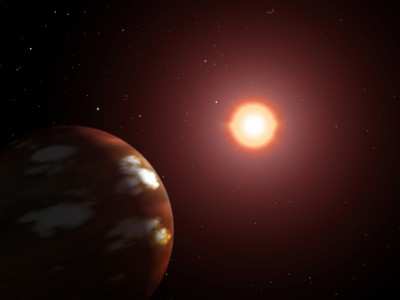Takes A Long Time To Cook One Up
 Planets are built over a long period
of massive collisions between rocky bodies as big as mountain
ranges, astronomers announced last week.
Planets are built over a long period
of massive collisions between rocky bodies as big as mountain
ranges, astronomers announced last week.
New observations from NASA's Spitzer Space Telescope reveal
surprisingly large dust clouds around several stars. These clouds
most likely flared up when rocky, embryonic planets smashed
together. The Earth's own Moon may have formed from such a
catastrophe. Prior to these new results, astronomers thought
planets were formed under less chaotic circumstances.
"It's a mess out there," said Dr. George Rieke of the University
of Arizona, Tucson, first author of the findings and a Spitzer
scientist. "We are seeing that planets have a long, rocky road to
go down before they become full grown."
Spitzer was able to see the dusty aftermaths of these collisions
with its powerful infrared vision. When embryonic planets, the
rocky cores of planets like Earth and Mars, crash together, they
are believed to either merge into a bigger planet or splinter into
pieces. The dust generated by these events is warmed by the host
star and glows in the infrared, where Spitzer can see it.
The findings will be published in an upcoming issue of the
Astrophysical Journal. They mirror what we know about the formation
of our own planetary system. Recent observations from studies of
our Moon's impact craters also reveal a turbulent early solar
system. "Our Moon took a lot of violent hits when planets had
already begun to take shape," Rieke said.
According to the most popular theory, rocky planets form
somewhat like snowmen. They start out around young stars as tiny
balls in a disc-shaped field of thick dust. Then, through sticky
interactions with other dust grains, they gradually accumulate more
mass. Eventually, mountain-sized bodies take shape, which further
collide to make planets.
Previously, astronomers envisioned this process proceeding
smoothly toward a mature planetary system over a few million to a
few tens of millions of years. Dusty planet-forming discs, they
predicted, should steadily fade away with age, with occasional
flare-ups from collisions between leftover rocky bodies.
Rieke and his colleagues have observed a more varied
planet-forming environment. They used new Spitzer data, together
with previous data from the European Space Agency's Infrared Space
Observatory and the joint NASA, United Kingdom and the Netherlands'
Infrared Astronomical Satellite. They looked for dusty discs around
266 nearby stars of similar size, about two to three times the mass
of the Sun, and various ages. Seventy-one of those stars were found
to harbor discs, presumably containing planets at different stages
of development. But, instead of seeing the discs disappear in older
stars, the astronomers observed the opposite in some cases.
"We thought young stars, about one million years old, would have
larger, brighter discs, and older stars from 10 to 100 million
years old would have fainter ones," Rieke said. "But we found some
young stars missing discs and some old stars with massive
discs."

This variability implies planet-forming discs can become choked
with dust throughout the discs' lifetime, up to hundreds of
millions of years after the host star was formed. "The only way to
produce as much dust as we are seeing in these older stars is
through huge collisions," Rieke said.
Before Spitzer, only a few dozen planet-forming discs had been
observed around stars older than a few million years. Spitzer's
uniquely sensitive infrared vision allows it to sense the dim heat
from thousands of discs of various ages. "Spitzer has opened a new
door to the study of discs and planetary evolution," said Dr.
Michael Werner, project scientist for Spitzer at NASA's Jet
Propulsion Laboratory, Pasadena (CA).
"These exciting new findings give us new insights into the
process of planetary formation, a process that led to the birth of
planet Earth and to life," said Dr. Anne Kinney, director of the
universe division in the Science Mission Directorate at NASA
Headquarters, Washington. "Spitzer truly embodies NASA's mission to
explore the universe and search for life," she said.
 ANN's Daily Aero-Linx (05.06.25)
ANN's Daily Aero-Linx (05.06.25) ANN's Daily Aero-Term (05.06.25): Ultrahigh Frequency (UHF)
ANN's Daily Aero-Term (05.06.25): Ultrahigh Frequency (UHF) ANN FAQ: Q&A 101
ANN FAQ: Q&A 101 Classic Aero-TV: Virtual Reality Painting--PPG Leverages Technology for Training
Classic Aero-TV: Virtual Reality Painting--PPG Leverages Technology for Training Airborne 05.02.25: Joby Crewed Milestone, Diamond Club, Canadian Pilot Insurance
Airborne 05.02.25: Joby Crewed Milestone, Diamond Club, Canadian Pilot Insurance




